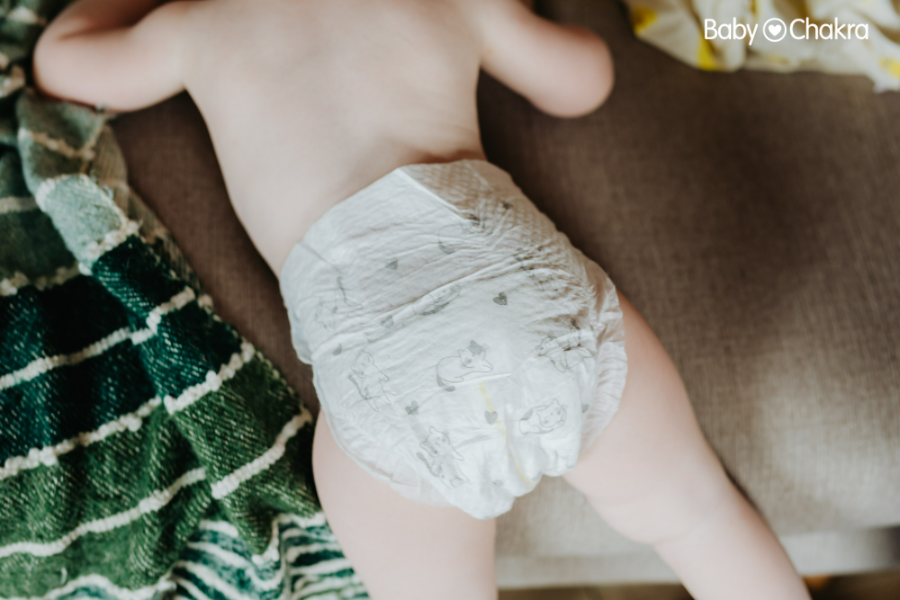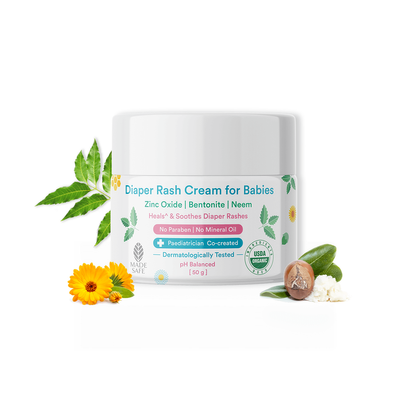
How To Choose The Right Diaper Rash Cream For Your Baby
4 May 2022 | 6 min Read
Sayani Basu
Author | 607 Articles
Diaper rashes are a common skin concern for babies and can cause red splotches and scales to appear in the genital area and on the baby’s bottom. They are a form of inflamed skin (dermatitis). Sometimes, the rashes might spread up the child’s legs and to the stomach.
Diaper rash is often related to wet or infrequently changed diapers, chafing and skin sensitivity. It is more common in babies of six to nine months old.
Here’s everything you need to know about diaper rashes.
Symptoms Of Diaper Rash
The symptoms of diaper rashes are:
- Skin signs: Diaper rashes are marked by red, tender-looking skin on buttocks, thighs and genitals.
- Changes in your baby’s disposition: You might notice that your baby seems more uncomfortable than usual, especially during diaper changes.
A baby with a diaper rash often cries when the diaper area is washed or touched.
Causes
Some of the causes of diaper rashes are:
- Irritation from stool and urine: Prolonged exposure to urine or stool can irritate your baby’s sensitive skin. Your baby might be more prone to diaper rash if the little one is experiencing frequent bowel movements or diarrhoea. This is so because faeces irritates your little one more than urine.
- Chafing or rubbing: Tight-fitting diapers or clothing that rubs against the skin can also lead to a rash.
- Irritation from a new product: Your baby’s skin might react to baby wipes, a new set of disposable diapers, or a detergent, bleach or fabric softener used to launder cloth diapers.
Sometimes, the ingredients used in some baby lotions, powders and oils can also add to the problem.
- Bacterial or yeast infection: What begins as a simple skin infection can spread to the surrounding region. The buttocks, thighs and genitals covered by a diaper are especially vulnerable because it’s warm and moist, making a breeding ground for bacteria and yeast.
These rashes can be found within the creases of the skin, leading to red dots scattered around the creases.
- Introduction of new foods: As the little one starts to eat solid foods, the content of their stool changes. This can also increase the likelihood of diaper rashes.
Changes in your baby’s diet can increase the frequency of stools, which in turn can lead to diaper rash.
If your baby is breast-fed, he or she can develop diaper rash in response to something you have eaten.
- Sensitive skin: Babies with skin conditions, such as atopic dermatitis or seborrheic dermatitis (eczema), are more likely to develop diaper rashes.
- Use of antibiotics: Antibiotics kill bacteria, both the good and the bad ones. When a baby takes antibiotics, the good bacteria that keeps yeast growth in check may be depleted. This can result in diaper rash due to yeast infection.
Antibiotic use can also increase the risk of diarrhoea. Breast-fed babies whose mums take antibiotics are also at increased risk of diaper rashes.
Treatment
Babies wear diapers the whole day. As a result, a baby’s bottom is constantly exposed to bacteria-breeding moisture. Therefore, a baby powder and a diaper rash cream are an essential part of a baby’s personal care regime to prevent and treat diaper rashes.
- Baby powder: A baby-safe powder can be a great treatment option for diaper rashes. It absorbs moisture and reduces skin-on-skin friction, which helps to prevent or treat diaper rashes.
- Air out baby’s diaper area: Let your baby go diaper-free for at least 10-15 minutes for at least 3-4 times a day.
- Keep the diaper area dry and clean: Always make sure the baby’s diaper area is dry and clean and dry. You can do this by checking your baby’s diaper frequently and replacing the wet or soiled ones with a fresh one.
- Diaper rash cream: A diaper rash cream is perhaps the best thing for a diaper rash. It acts as a moisturiser to treat or prevent dry, rough, scaly, itchy skin and minor skin irritations.
How To Choose The Right Diaper Rash Cream For Your Baby?
You should opt for a diaper rash cream that promises to prevent, treat, and soothe diaper rashes and skin inflammation. It will create a layer between the wetness and the skin, thereby protecting your baby.
Some diaper rash creams are infused with organic chamomile oil and hydrolyzed wheat protein. They repair the skin and retain moisture. While other creams are packed with organic jojoba oil and shea butter that increase collagen production and help to reduce rashes.
It’s advisable to use diaper rash creams that contain oils like the moringa oil, calendula oil, and other nourishing ingredients like aloe vera extracts, organic shea butter that are a safe solution for babies.
These ingredients soothe and heal your baby’s sensitive skin, and protects it from diaper rashes. The natural formula ensures that there are no chances of allergic reactions.
Choose diaper rash creams that contain ingredients that are completely devoid of mineral oil, petroleum jelly, paraben, phenoxyethanol, synthetic colour and fragrance, and silicone.
Apply a thick layer of the cream to the entire diaper area. Be generous in applying the cream. This can be used at every diaper change to help treat and prevent diaper rashes.
Key Takeaways
Although diaper rashes are common, it is recommended to consult your child’s paediatrician in case of an infected diaper rash. This form of severe diaper rash can be accompanied by fever, blisters on the diaper area, pus or discharge that drains from the diaper area and redness along with swelling.
There are some tips that can help mums to deal with their baby’s diaper rashes. It is advisable to wash your hands before and after every diaper change. It is important to check your baby’s diaper often, and change it after it gets wet or soiled.
A


Related Topics for you
Suggestions offered by doctors on BabyChakra are of advisory nature i.e., for educational and informational purposes only. Content posted on, created for, or compiled by BabyChakra is not intended or designed to replace your doctor's independent judgment about any symptom, condition, or the appropriateness or risks of a procedure or treatment for a given person.

